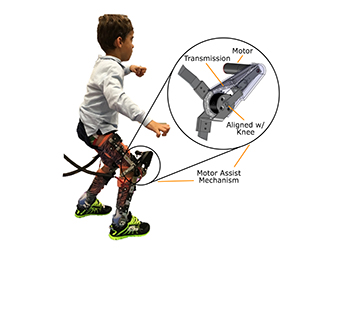Robotic Exoskeleton Helps Alleviate Crouch Gait in Children with Cerebral Palsy

PHOTO CREDIT: NIH CLINICAL CENTER
The pediatric exoskeleton, seen above, shows the custom-designed motorized assembly for providing knee-extension assistance during walking.
With motors, sensors, and electronic-technology-powered braces wrapped around their legs, several pediatric patients participating in a Rehabilitation Medicine clinical trial looked like characters from the Iron Man or Transformers movies–and more importantly, they felt like the superheroes they resembled. The patients, all of whom have cerebral palsy, walked with crouch gait, or excessive bending of the knees. To improve their walking, researchers led by staff scientist Thomas Bulea (in the Clinical Center’s Rehabilitation Medicine Department) created the first robotic exoskeleton specifically designed to treat crouch gait in children with cerebral palsy by providing powered knee-extension assistance at key points during the walking cycle.
Cerebral palsy is the most prevalent childhood movement disorder in the United States, with approximately 10,000 new cases diagnosed each year. It is caused by a brain injury or abnormality in infancy or early childhood that disrupts the control of movement, posture, and balance. Crouch gait is a common and debilitating condition in children with this disorder. Despite conventional treatments (including muscle injections, surgery, physical therapy, and orthotics), crouch gait can lead to a progressive degeneration of walking function, ultimately resulting in the loss of walking ability in roughly half of adults with the disorder.
Bulea and his team are among the first to create a device like this for children. Most wearable exoskeletons are intended for adults with paralysis and replace the lost function of the user’s muscles to restore walking ability. Bulea’s team designed their exoskeleton “to change the way children with crouch gait from cerebral palsy walk.”
The exoskeleton helps children with crouch gait by tracking the natural movement patterns of their limbs and supplying motorized assistance for knee extension at the appropriate times of the walking cycle.

PHOTO CREDIT: NIH CLINICAL CENTER
A child with cerebral palsy, assisted by the NIH pediatric exoskeleton, walks across a surface.
The majority of the children, ages 5 to 19, were able to improve their knee extension by up to 37 degrees while wearing the brace. According to Bulea, it was the first time in their life some of the parents had seen their children walk while standing that tall.
“Our results show that the exoskeleton can safely and effectively change the posture of a child while they wear it,” said Bulea. “The exciting part is that the children’s muscle activity was preserved when they walked in this new way with the exoskeleton, suggesting that long-term use of this device might be a viable way to train a new walking pattern.”
The team hopes that after proper validation of the science, the technology will move out of the lab and into clinics among the general public.
“Ultimately, our goal is to have this device reach as many children who can benefit as possible,” Bulea concluded.
The team is also planning studies in children with more-severe gait deficits from cerebral palsy as well as in those with other disorders such as spina bifida or muscular dystrophy.
This article is adapted from one that appeared in the September 2017 issue of the Clinical Center News. (CC authors: Z.F. Lerner, D.L. Damiano, and T.C. Bulea, Sci Transl Med 9:eaam9145, 2017; DOI:10.1126/scitranslmed.aam9145).
This page was last updated on Friday, April 8, 2022
